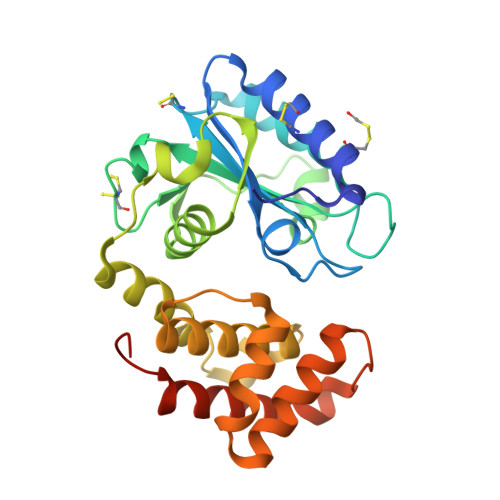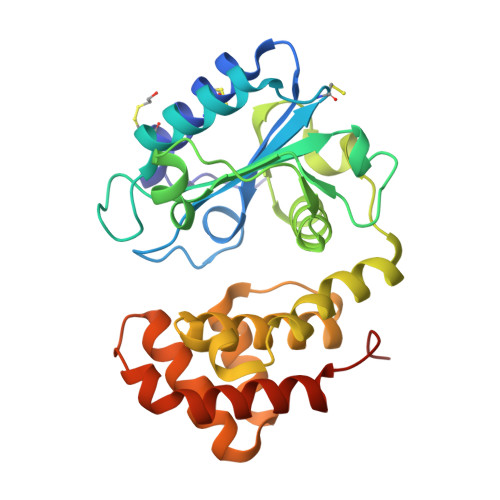Structural mechanism of AadA, a dual-specificity aminoglycoside adenylyltransferase fromSalmonella enterica.
Stern, A.L., Van der Verren, S.E., Kanchugal P, S., Nasvall, J., Gutierrez-de-Teran, H., Selmer, M.(2018) J Biol Chem 293: 11481-11490
- PubMed: 29871922
- DOI: https://doi.org/10.1074/jbc.RA118.003989
- Primary Citation of Related Structures:
5G4A, 5LPA, 5LUH, 6FZB - PubMed Abstract:
Streptomycin and spectinomycin are antibiotics that bind to the bacterial ribosome and perturb protein synthesis. The clinically most prevalent bacterial resistance mechanism is their chemical modification by aminoglycoside-modifying enzymes such as aminoglycoside nucleotidyltransferases (ANTs). AadA from Salmonella enterica is an aminoglycoside (3″)(9) adenylyltransferase that O- adenylates position 3″ of streptomycin and position 9 of spectinomycin. We previously reported the apo-AadA structure with a closed active site. To clarify how AadA binds ATP and its two chemically distinct drug substrates, we here report crystal structures of WT AadA complexed with ATP, magnesium, and streptomycin and of an active-site mutant, E87Q, complexed with ATP and streptomycin or the closely related dihydrostreptomycin. These structures revealed that ATP binding induces a conformational change that positions the two domains for drug binding at the interdomain cleft and disclosed the interactions between both domains and the three rings of streptomycin. Spectinomycin docking followed by molecular dynamics simulations suggested that, despite the limited structural similarities with streptomycin, spectinomycin makes similar interactions around the modification site and, in agreement with mutational data, forms critical interactions with fewer residues. Using structure-guided sequence analyses of ANT(3″)(9) enzymes acting on both substrates and ANT(9) enzymes active only on spectinomycin, we identified sequence determinants for activity on each substrate. We experimentally confirmed that Trp-173 and Asp-178 are essential only for streptomycin resistance. Activity assays indicated that Glu-87 is the catalytic base in AadA and that the nonadenylating E87Q mutant can hydrolyze ATP in the presence of streptomycin.
Organizational Affiliation:
Department of Cell and Molecular Biology, Uppsala University, BMC, Box 596, SE-751 24 Uppsala, Sweden.
























